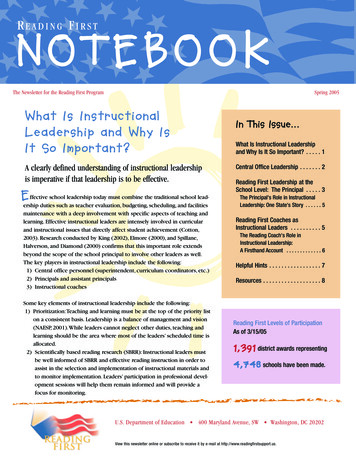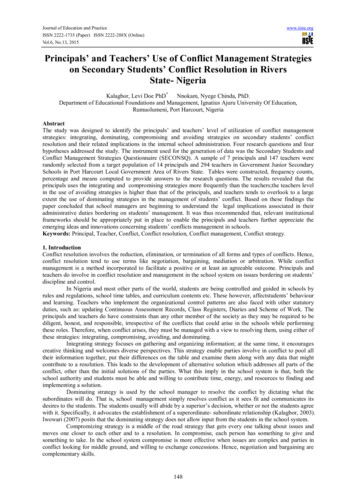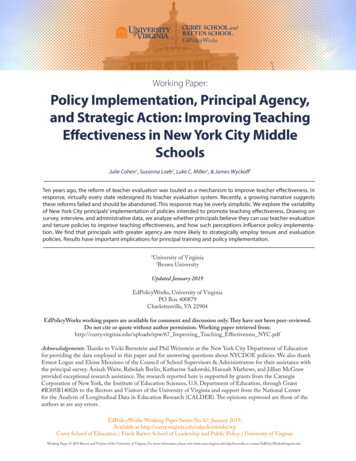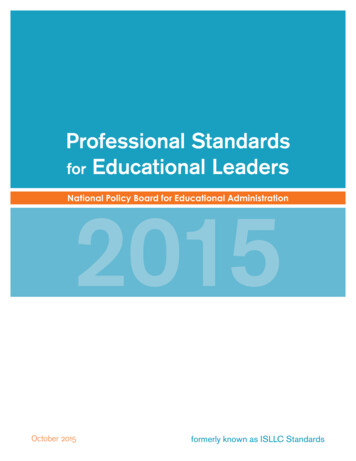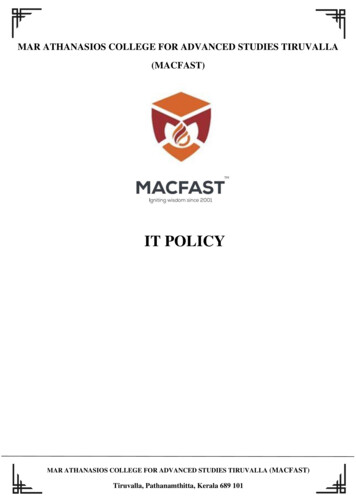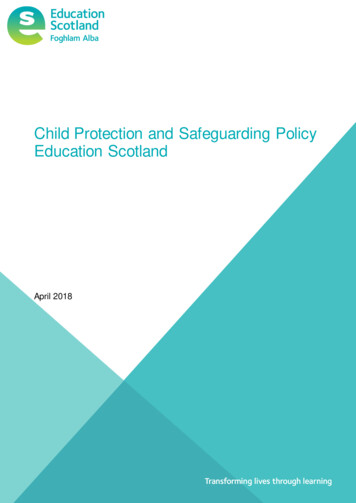
Transcription
SupportingPrincipals’ LearningKey Features of Effective ProgramsLeib Sutcher, Anne Podolsky, and Danny EspinozaFEBRUARY 2017
Supporting Principals’ Learning:Key Features of Effective ProgramsLeib Sutcher, Anne Podolsky, and Danny Espinoza
AcknowledgmentsThe authors would like to thank Peg Winkelman, Professor and Department Chair, Departmentof Educational Leadership, California State University Easy Bay, for her valuable assistance inassembling research that informed various aspects of our paper. We also thank the following LPIcolleagues for their contributions to the research process: Linda Darling-Hammond, Tara Kini, andPatrick Shields. In addition, we appreciate the insights and feedback offered by our colleagues:Roberta Furger, Roneeta Guha, and the entire Educator Quality Team. And we thank BulletproofServices, Penelope Malish, and Nik Schulz for their editing and design contributions to this project,and Lisa Gonzales for overseeing the editorial process. Without the generosity of time and spirit ofall of the aforementioned, this work would not have been possible.This research was supported by grants from the Stuart Foundation and the S. D. Bechtel, Jr.Foundation. Core operating support for the Learning Policy Institute is provided by the SandlerFoundation.External ReviewersThis report benefited from the insights and expertise of two external reviewers: Kenneth Leithwood,Professor of Educational Leadership and Policy at the Ontario Institute for Studies in Education,University of Toronto; and Kelly Pollitt, Chief Strategist for Policy and Alliances at the NationalAssociation of Elementary School Principals. We thank them for the care and attention they gavethe report. Any remaining shortcomings are our own.The appropriate citation for this report is: Sutcher, L., Podolsky, A., & Espinoza, D. (2017). Supportingprincipals’ learning: Key features of effective programs. Palo Alto, CA: Learning Policy Institute.This report can be found online at ting-principals-learning.This work is licensed under the Creative Commons Attribution—NonCommercial 4.0 InternationalLicense. To view a copy of this license, visit RNING POLICY INSTITUTE SUPPORTING PRINCIPALS’ LEARNING: KEY FEATURES OF EFFECTIVE PROGRAMS
Table of ContentsExecutive Summary. vIntroduction: Why Principals Matter.1The Building Blocks of Quality.3Organizational Partnerships That Support Learning.31. Close collaboration between programs and school districts.32. Purposeful and targeted recruitment.4Programs Structured to Support Learning.61. Cohorts of principal candidates.62. Networks of practicing principals.6Meaningful and Authentic Learning Opportunities.81. Problem-based learning opportunities.82. Field-based internships and coaching/mentoring by an expert.9Learning Opportunities Focused on What Matters. 121. Strong focus on improving schoolwide instruction. 122. Attention to creating collegial organizations. 133. Using data for change. 14Policy Implications. 16Conclusion. 18Endnotes. 19About the Authors. 30FiguresFigure 1.Figure 2.Figure 3.The Building Blocks of High-Quality Principal Preparation and ProfessionalDevelopment Programs.3San Diego Unified School District’s Principal In-Service Program Structure.7How High-Quality Principal Preparation and Development Pays Off for Students,Schools, and States. 17LEARNING POLICY INSTITUTE SUPPORTING PRINCIPALS’ LEARNING: KEY FEATURES OF EFFECTIVE PROGRAMS
Executive SummaryImproving student achievement requires strong school leadership. In the wake of the Every StudentSucceeds Act, many states are redesigning their education systems to better prepare students fortoday’s dynamic, knowledge-driven economy. Implementing new education initiatives related tocurriculum, instruction, accountability, and social and emotional learning requires substantialexpertise on the part of principals. Furthermore, principals play a critical role in addressingwidespread teacher shortages by creating school environments that attract and retain competentteachers. The most effective principals assume a range of responsibilities, including settingdirection, developing people, redesigning the organization, and leading instruction.There is a great deal for school leaders to learn in order to manage all of these responsibilitiesproductively. Fortunately, the field has learned a lot in recent years about how to constructprincipal preparation and professional development programs that are effective in enablingprincipals to improve school outcomes, such as increasing principal and teacher effectiveness andretention and improving student learning. Research points to several key building blocks of suchprograms. These include: Organizational partnerships that support learning1. Close collaboration between programs and school districts. High-quality programspartner with school districts in a mutually beneficial blend of research and practice.2. Purposeful and targeted recruitment. High-quality programs recruit teachers withleadership potential to enter the principalship, ideally from the communities theyplan to serve. Programs structured to support learning1. Cohorts of principal candidates. High-quality preparation programs structure learningand courses to be carried out in collaboration amongst a small group of peers.2. Networks of practicing principals. High-quality in-service learning utilizesprofessional learning communities where school leaders learn together on the job. Meaningful and authentic learning opportunities1. Problem-based learning opportunities. Effective programs use context-specificproblems to connect coursework and practice to enrich candidates’ skill development.2. Field-based internships and coaching by an expert. High-quality programs supportprincipals’ development through internships and on-the-job coaching by strong andsupportive leaders. Learning opportunities focused on what matters1. Strong focus on improving schoolwide instruction. High-quality programs havecurricula focused on instruction and school improvement.2. Attention to creating collegial organizations. High-quality programs prepareeducators to create environments where teachers, staff, and students engage in continuallearning and improvement.3. Using data for change. High-quality programs train educators to use data and collectiveinquiry to identify problems and address needs, in collaboration with staff, parents, andcommunity organizations.LEARNING POLICY INSTITUTE SUPPORTING PRINCIPALS’ LEARNING: KEY FEATURES OF EFFECTIVE PROGRAMSv
Strong education systems typically invest in the preparation and development of principals.Although high-quality principal training requires financial investments, the benefits can besubstantial when considering a principal’s influence on student achievement, as well as teacherquality and retention. States can invest in high-quality principals by using federal funds in ESSA forteacher and school leader development. Policymakers can use the evidence base for what makes aneffective preparation and development program to increase the odds that students are in schoolsled by well-prepared principals.LEARNING POLICY INSTITUTE SUPPORTING PRINCIPALS’ LEARNING: KEY FEATURES OF EFFECTIVE PROGRAMSvi
Introduction: Why Principals MatterSchoolwide improvement requires strong school leadership. In response to the Every StudentSucceeds Act (ESSA), communities across the country are redesigning their education systemsby raising academic standards, adopting new curricula, and investing in high-quality teachers.Communities are also considering how best to address the academic, social, and emotional needs ofstudents. Schools serving the most vulnerable students are especially interested in addressing theoften high rates of teacher turnover that can hurt student achievement.1All of these efforts require a strong principal. Infact, principals have been found to be a crucialschool-level factor associated with studentachievement—second only to teachers’ classroominstruction.2 One study noted that “there arevirtually no documented instances of troubledschools being turned around without interventionby a powerful leader.”3“there are virtually no documentedinstances of troubled schoolsbeing turned around withoutintervention by a powerful leader.”Furthermore, principal support is one of the mostimportant factors cited by teachers in their decisions about whether to stay in a school or in theprofession.4 Thus, principals’ abilities to create the positive working conditions and collaborative,supportive environments that retain teachers will play a critical role as school districts around the countrystruggle to address widespread shortages, particularly in mathematics, science, and special education.5Research finds that, across differing school and community contexts, effective principals setdirection, develop people, redesign organizations, and lead instruction.6Effective principals set direction by establishing a vision for a strong learning environment thatcan encourage teacher growth and retention7 and drive a culture of continuous improvement.8 Sucha vision is informed by data; it empowers staff to share in school decision making, and it inspireseducators and students around teaching and learning.9 Accordingly, principals need to learn how tocreate and implement a strategic vision that ultimately leads to improved student well-being andacademic achievement.Principals also develop people, in part through their influence on the quality of teachers thata school attracts and retains.10 In fact, the quality of principal support is often the top factorteachers identify in their decision to leave or stay in the profession.11 Principals must learn howto attract quality teachers, as well as how to create collaborative environments where teachersand students thrive.Strong principals redesign organizations by shaping the teaching and learning conditions thathelp all students learn and succeed. Principals have an important role in making the necessaryshift to whole-child teaching practices, including the integration of social and emotional learning.For example, principals can influence the school environment to support students in becomingself-directed learners who understand and mitigate emotions, learn to set goals, value diverseviewpoints, build strong relationships, become responsible decision makers, and productivelynavigate personal and interpersonal situations.12 Therefore, principals must learn how to fostersupportive and engaging school environments that promote all students’ acquisition of theknowledge and dispositions that help them succeed in school, college, and career.LEARNING POLICY INSTITUTE SUPPORTING PRINCIPALS’ LEARNING: KEY FEATURES OF EFFECTIVE PROGRAMS1
Talented principals lead instruction by helping teachers learn how to implement increasinglyrigorous academic standards that emphasize higher-order thinking skills. A former principalcommented that today’s best principals “know what good and effective instruction looks like,so they can provide feedback to guide teachers.”13 These principals work directly with teachersto strengthen and provide feedback on their practice; offer meaningful professional learningopportunities to improve instruction; foster a safe space for teachers to critique, learn from, andcollaborate with each other; analyze multiple forms of student data with the aim of improvinginstruction; and set high expectations for teachers and students.14 Consequently, principalpreparation and professional development programs need to attract strong educators and helpthem learn how to lead schoolwide instructional improvements.Developing excellent principals who can set direction, develop people, redesign organizations, andlead instruction requires a system of high-quality preparation and professional development.15This paper summarizes the elements of high-quality principal preparation and professionaldevelopment programs that have been associated with positive school outcomes, ranging fromstudent achievement, to staff and student perceptions of school climate, to principal efficacy andretention. To illustrate how these elements work together to develop strong principals, the paperalso includes descriptions of four programs that have been found to produce effective principals.The National Institute for School Leadership Executive DevelopmentProgram: A Cost-Effective Model for Improving Student AchievementThe National Institute for School Leadership (NISL) Executive Development Program provides schoolleaders with a research-based professional learning program that helps them improve their effectiveness.Multiple studies have found that after controlling for student characteristics and prior school achievementtrends, schools led by NISL principals outperform comparable schools led by non-NISL principals in studentachievement over the 4-year period studied.16The program’s curriculum is sequenced to develop principals with the capacity to be strategic thinkers, theconfidence and knowledge to be effective instructional leaders, and the ability to establish a supportive culturefor students and teachers alike. Active in 25 states, NISL works with both individual districts and statewideprincipal development efforts.17The Executive Development Program places principals in cohort groups of around 25 or 30, where they spend24 days training with an NISL instructor over a 12- to 18-month period. The peer-to-peer interactions amongstthe principals in the NISL network provide a professional learning community for the principals that often leadsto ongoing collaboration amongst program participants after completing the course.18The Executive Development Program uses a mix of problem-based teaching methods, including groupdiscussions, role-playing, video case studies, and simulations, as well as on-the-job learning, including ActionLearning Projects that aim to address the actual challenges principals face in their current schools. Thecurriculum is designed for principals in all stages of their career. The curriculum focuses on instructionalleadership, including how to foster teacher collaboration; leadership for excellence in literacy, mathematics,and science; implementing standards-based instruction; and coaching teachers. In addition, the curriculumemphasizes principals as direction setters—teaching principals to think strategically, use data to informdecisions, and build a culture of improvement.19The NISL program allows districts to build lasting leadership capacity by offering the “train-the-trainer” program,which supplements the existing Executive Development Program with additional guidance and feedback onfacilitation with each unit so principals or district staff members can bring this knowledge back to their districtto teach other school leaders.20This program is highly cost-effective— 4,000 per candidate—which one study estimates as 117 per additionalstudent achieving proficiency.21LEARNING POLICY INSTITUTE SUPPORTING PRINCIPALS’ LEARNING: KEY FEATURES OF EFFECTIVE PROGRAMS2
The Building Blocks of QualityTo identify the elements of high-quality principal development programs supported in theresearch, we analyzed peer-reviewed research, or research by organizations with established reviewprocesses, published within the past two decades. Specifically, we reviewed studies that connectedcomponents of principal preparation and professional development to improved school outcomes,such as improved student learning, increased principal and teacher effectiveness and retention,and improved perceptions of school climate. Below, we summarize the organizational partnerships,structures, nature, and focus of high-quality principal preparation and professional developmentprograms supported in the research.Figure 1The Building Blocks of High-Quality Principal Preparation andProfessional Development ProgramsHigh-Quality PrincipalPreparation & DevelopmentApplied LearningCohorts & Networksfor Collegial LearningPartnerships BetweenDistricts & ProgramsFocus on Instruction, Organizations& Using Data for ChangeOrganizational Partnerships That Support LearningHigh-quality programs require strong working relationships between the district and principalpreparation/training program that involve: (1) close collaboration and (2) targeted candidaterecruitment.22 Strong partnerships also provide a foundation for the other features of effectiveprograms discussed in this paper.1. Close collaboration between programs and school districtsHigh-quality programs partner with school districts in a mutually beneficial blend of research andpractice. Effective partnerships between principal development programs and districts typicallyinvolve coordination on curriculum, active recruitment of promising teacher leaders, and theprovision of authentic learning opportunities, such as residencies, where principal candidateswork alongside mentor principals in a low-stakes, in-depth, and reflective environment.23 StrongLEARNING POLICY INSTITUTE SUPPORTING PRINCIPALS’ LEARNING: KEY FEATURES OF EFFECTIVE PROGRAMS3
partnerships provide candidates with acoherent experience in their clinical trainingand coursework that helps candidates bridgetheory into practice. When districts andprograms collaborate, candidates receive amore coordinated and holistic preparation andtraining experience.24When districts and programscollaborate, candidates receivea more coordinated and holisticpreparation and trainingexperience.The structure of partnerships can varydepending on the unique context of a givendistrict, program, and community. In one example, the University of Illinois at Chicago worksclosely with Chicago Public Schools (CPS) to deliver an authentic residency as a part of itsDoctorate in Urban Education Leadership program. “Triad meetings”—between candidates, theirCPS mentor principals, and UIC leadership coaches—help coordinate and direct support betweenthe two institutions throughout the yearlong residency. Furthermore, the two institutionshave worked closely to align curriculum and program expectations with district leadershipcompetencies (see description of the program on page 11).252. Purposeful and targeted recruitmentHigh-quality programs recruit teachers with leadership potential to enter the principalship, ideallyfrom the communities they plan to serve. Multiple studies suggest that a common characteristicof effective principal preparation programs is the careful recruitment and selection of talentedindividuals. Successful programs actively identify excellent educators with instructional leadershippotential and a commitment to serve their community. Often, partnering districts recommendcandidates whom they have identified as promising future leaders who also reflect the demographiccharacteristics of their students.26Rather than simply waiting for candidates to decide on their own to sign up for a program, targetedrecruitment can attract more dynamic and diverse candidates into school leadership positions.27 Anadministrator in a district working to improve principal quality noted how the district changed itsprincipal recruitment[From a process of] individual people self-selecting themselves, going into leadership[programs], when maybe they aren’t the right people to eventually be principals, andit’s allowing us to be very purposeful, very intentional, and taking [selected individuals]through a very supportive process.28Studies of successful principal preparation programs at Bank Street College, Delta State University,the University of Connecticut, and the University of San Diego found that these successfulprograms worked directly with partnering districts to recruit excellent teachers to their principalpreparation programs. The principal candidates in these programs were more likely to have beeninstructional coaches and teacher mentors, and also to be women and people of color, comparedto the norm across the country, as well as the norm in the programs before the partnerships werelaunched. Recruits in these programs were also more likely to become and remain principals, to feelcompetent, and to plan to stay in their jobs than their counterparts across the nation.29LEARNING POLICY INSTITUTE SUPPORTING PRINCIPALS’ LEARNING: KEY FEATURES OF EFFECTIVE PROGRAMS4
The New Leaders principal preparation program, also carefully recruits candidates and preparescandidates in ways and prepares candidates in ways that produce similar outcomes (see descriptionof the program below).New Leaders’ Aspiring Principals Preparation Program:A Program Partnering With Districts to Prepare Principals to LeadHigh-Need SchoolsNew Leaders, a nonprofit organization, offers an Aspiring Principals preparation program in over 20 cities in theU.S. that prepares school leaders to serve in high-need urban schools. New Leaders attracts highly qualifiedand diverse individuals, often recommended by the schools or districts in which they are teaching, who supporttheir training for the principalship. The program actively identifies and recruits candidates with classroomexperience, a history of student improvement, and a belief that all students are capable of success.30Approximately 64% of New Leaders alumni identify as people of color, as compared to 20% of principals andteachers nationally.31Candidates participate in yearlong residencies in which they work alongside mentor principals. The NewLeaders residency is designed to expose candidates to the day-to-day realities of a principalship as well asproblem-based learning opportunities such as role-playing and simulations, while receiving feedback, support,and coaching. New Leaders also provides ongoing support for its candidates after they become principals,generally providing 2 years of mentoring once per week for at least 2 hours.32Candidates learn together in a cohort where they “share challenges and reflect with their peers forginga support network that will last through their careers.”33 New Leaders’ curriculum and experiences focuson “strengthening instruction across a building, enacting ambitious improvement plans, and fostering highexpectations and shared accountability.”34 This includes specific coursework on data-driven decision making,cultural competence, mathematics and science instruction, and setting organizational culture. New Leadersclosely partners with school districts and charter-management organizations to ensure that its graduatesare placed in high-need schools and that each district supports its principals by giving them the necessaryresources to enable their growth as leaders.35Just as the program urges its candidates to do, New Leaders engages in a continuous improvement processby setting ambitious standards, collecting data to monitor its progress toward those standards, and refining itsprogram based on data. New Leaders’ Aspiring Principals program underwent an evaluation, which found that,on average, students in schools led by principals selected and trained in the New Leaders program experiencedlarger gains in achievement than students in schools led by non-New Leaders principals, controlling for studentcharacteristics. The study concluded that the three key elements of New Leaders’ preparation that helpprincipals to ultimately improve student learning include “selective recruitment and admissions, training andendorsement, and support for principals early in their tenures.”36In addition, the study found that principals prepared in the program were more likely to remain in theirschools for 3 or more years compared to other newly placed principals.37 This finding is important becauseprincipal turnover is also associated with lower student achievement gains, particularly in high-poverty,low-achieving schools.38LEARNING POLICY INSTITUTE SUPPORTING PRINCIPALS’ LEARNING: KEY FEATURES OF EFFECTIVE PROGRAMS5
Programs Structured to Support LearningHigh-quality programs recognize that learning is a social activity, and include structures to trainand support principals, such as (1) cohorts and (2) networks. A veteran principal from Californiastated, regarding her work as an administrator, “No matter where you work, there is a feeling ofisolation.”39 High-quality principal preparation and in-service programs curb principal isolationby envisioning leadership as a communal activity. Having principals learn together in cohorts andprofessional learning networks reflects the collegial and collaborative school environments thatthey will both work within and foster.1. Cohorts of principal candidatesHigh-quality preparation programsCohorts allow school leadersstructure learning and courses to take placein collaboration among a small group ofwho are often isolated inpeers. Multiple studies of effective principaltheir positions to turn to otherpreparation programs have found that a keyaspect of programs is the fact that aspiringprofessionals facing the sameprincipals learn in cohorts.40 The positivechallenges for support, reflection,effects of cohort learning include an increasedand insight.likelihood of participants completing the41program, participants perceiving that theyare better prepared,42 and more collegialand supportive learning environments.43 Inwell-run programs that operate in cohorts or professional learning communities, participantsmay also develop skills in conflict resolution, information processing, and, not surprisingly,cooperation.44 Cohorts allow school leaders who are often isolated in their positions to turn toother professionals facing the same challenges for support, reflection, and insight.The benefits of cohorts often persist past the completion of preparation programs as graduatesuse the network to exchange ideas, share resources, and engage in problem solving and criticalreflection well into their professional careers.45 A graduate from the Principals Institute at BankStreet College described the continued benefits of her cohort group:We bounce frustrations as well as successes and questions off each other. And I’ll havecolleagues call me back [with] a question when they need an answer to something.46In this way, cohorts provide an ongoing network of support from practicing principals.2. Networks of practicing principalsHigh-quality in-service learning programs also utilize networks or professional learningcommunities in which school leaders learn together on the job. Practicing principals who are partof networks or well-functioning professional learning communities that meet regularly and workon common problems of practice can provide opportunities for principals to share best practices,develop a shared orientation toward instruction, and problem solve through mutual, interactive,and self-initiated learning. To achieve these benefits, communities typically possess a commitmentto students’ needs, a regular time for meeting, user-friendly data to analyze problems, and awillingness to share authority through distributed leadership.47LEARNING POLICY INSTITUTE SUPPORTING PRINCIPALS’ LEARNING: KEY FEATURES OF EFFECTIVE PROGRAMS6
One New York City principal involved in a comprehensive principal network described the value ofthe network in the following way:We got a chance to sit with our networks, bring in our work, and see other principals’ideas who have been principals longer then I have, who have a lot more to share. I’malways asking, “How did you do that?” or “Can I come to your school and see that?”They are always open and willing.48Innovative programs and districts have replaced the one-time workshop approach to in-servicelearning with multiple professional learning opportunities where principals develop a broadernetwork of peers. For example, a study documenting San Diego Unified School District’s web oflearning supports for all princip
The Executive Development Program places principals in cohort groups of around 25 or 30, where they spend 24 days training with an NISL instructor over a 12- to 18-month period. The peer-to-peer interactions amongst the principals in the NISL network provide a professional learning community for the principals that often leads


